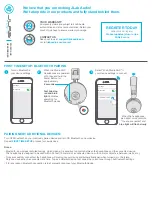
8
OPERATING INSTRUCTIONS DT 150
Thank you for selecting the DT 150 professional studio head-
phone. It has been made in Germany from high-grade materials
and assembled under stringent quality and performance tests to
provide you with a professional communications tool. Please take
some time to read through this instruction sheet to give you an
idea of the design criterion and some information on connection,
use and maintenance.
Design Features
The DT 150 is a closed dynamic studio headphone and it is
configured for use in broadcasting, film and recording studios.
The headphone is fully modular for easy servicing. A multi-
conductor cable is used to connect the DT 150 to external sources
and destinations via a custom connector assembly. Spare cables
for the DT 150 are available as straight or coiled. The headband
and earphone cushioning systems have been carefully designed
for maximum comfort and serviceability as we appreciate that the
DT 150 will be used for long periods of time.
Connection
The studio headphone DT 150 is delivered without connecting
cable. For the connecting cables available refer to “Optional
Accessories”.
The connecting cable K 100.00 is constructed using a tinsel-
conductor cord. This type of conductor resists repetitive bending
without breaking, but special care must be taken when making
solder joints to connectors. Where possible it is recommended to
fit crimped brass sleeves to the conductors and then solder the
sleeve to the connector. If direct solder connections have to be
made, use a high-temperature solder-pot to tin the tinsel
conductors before making the solder joint to the connector, but
be careful that the nylon thread does not melt. Direct solder
connections can be made to all other cables with free ends (for
cable connection refer to “Wiring Diagram”). On request, the
necessary plugs can be mounted at the factory.
Operation
The DT 150 is of a professional standard. It is important that the
external equipment they will be connected to are of good quality
and of the correct impedance and power ratings to get the best
performance from them. Please refer to the “Technical
Specifications” for detailed information.


































